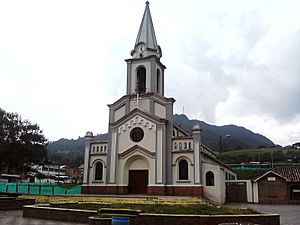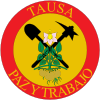Tausa facts for kids
Quick facts for kids
Tausa
|
|||
|---|---|---|---|
|
Municipality and town
|
|||

Church of Tausa
|
|||
|
|||

Location of the municipality and town inside Cundinamarca Department of Colombia
|
|||
| Country | |||
| Department | |||
| Province | Ubaté Province | ||
| Founded | 2 August 1600 | ||
| Area | |||
| • Municipality and town | 204 km2 (79 sq mi) | ||
| • Urban | 2 km2 (0.8 sq mi) | ||
| Elevation | 2,931 m (9,616 ft) | ||
| Population
(2015)
|
|||
| • Municipality and town | 8,801 | ||
| • Density | 43.14/km2 (111.74/sq mi) | ||
| • Urban | 1,058 | ||
| Time zone | UTC-5 (Colombia Standard Time) | ||
| Website | Official website: http://www.tausa-cundinamarca.gov.co/ | ||
Tausa is a town and municipality in Colombia. It is located in the Ubaté Province, which is part of the Cundinamarca region.
Tausa has always been an important place, especially because of its salt mine. It is located on the Altiplano Cundiboyacense, a high plateau in the Andes mountains. For the Muisca, who lived here long ago, Tausa was one of their most important sources of salt.
The main part of Tausa town is about 2,950 metres (9,680 ft) above sea level. Some areas of the municipality are even higher, reaching 3,700 metres (12,100 ft). Tausa is about 65 kilometres (40 mi) away from Bogotá, the capital city of Colombia.
Tausa shares its borders with several other towns. To the north, it borders San Cayetano, Carmen de Carupa, and Sutatausa. To the west, it borders Pacho. To the east, it borders Sutatausa, Cucunubá, and Suesca. Finally, to the south, it borders Nemocón and Cogua.
Contents
What Does the Name Tausa Mean?
The name Tausa comes from the ancient Chibcha language. In this language, "Tausa" means "tribute." A tribute was a payment or gift given by one ruler or state to another to show respect or obedience.
Tausa's History
Early Inhabitants and Salt Mining
People have lived in the Tausa area since the Herrera Period, which was a very long time ago. The town was a key place for mining halite, which is a type of salt. The Muisca, who were the original inhabitants, relied on this salt.
The zipa of Bacatá was the main leader who ruled over Tausa. The importance of mining in Tausa's history can still be seen today. The town's official seal includes symbols like a pick and a spade, which are tools used for mining.
Founding of Modern Tausa
The modern town of Tausa was officially founded on August 2, 1600. This was during the time when the Spanish arrived and began to establish new towns in the region.
Tausa's Economy
The people of Tausa mainly earn their living from three things:
- Agriculture: This means growing crops.
- Livestock farming: This involves raising animals like cows or sheep.
- Salt mining: This is still an important activity, just as it was for the Muisca people centuries ago.
See Also
 In Spanish: Tausa para niños
In Spanish: Tausa para niños




